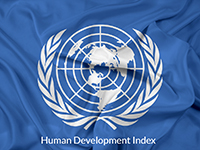What is India`s rank in Human Development Index?
Sakshi Education
India dropped two ranks in the United Nations’ Human Development Index this year, standing at 131 out of 189 countries.


The United Nations Development Programme (UNDP) for the first time, introduced a new metric to reflect the impact caused by each country’s per-capita carbon emissions and its material footprint, which measures the amount of fossil fuels, metals and other resources used to make the goods and services it consumes.
Norway topped the index, followed by Ireland and Switzerland. Hong Kong and Iceland complete the top five.
India, Bhutan, Bangladesh, Myanmar, Nepal, Cambodia, Kenya, and Pakistan were ranked under countries with medium human development with a rank in between 120 and 156 among the 189-counties.
In the BRICS grouping, Russia was 52 in the human development index, Brazil 84, and China 85.
India’s gross national income (GNI) per capita on the basis of purchasing power parity (PPP), too, fell from 6,829in2018to6,681 in 2019, it said.
India’s HDI value for 2019 is 0.645, which put the country in the medium human development category, positioning it at 131 out of 189 countries and territories.
Between 1990 and 2019, India’s HDI value increased from 0.429 to 0.645, an increase of 50.3%.
Between 1990 and 2019, India’s life expectancy at birth increased by 11.8 years, mean years of schooling increased by 3.5 years, and expected years of schooling increased by 4.5 years. India’s GNI per capita increased by about 273.9% between 1990 and 2019.
Under the Paris Agreement, India pledged to reduce the emission intensity of its GDP from the 2005 level by 33-35% by 2030 and to obtain 40% of electric power capacity from non-fossil fuel sources by 2030.
Norway topped the index, followed by Ireland and Switzerland. Hong Kong and Iceland complete the top five.
India, Bhutan, Bangladesh, Myanmar, Nepal, Cambodia, Kenya, and Pakistan were ranked under countries with medium human development with a rank in between 120 and 156 among the 189-counties.
In the BRICS grouping, Russia was 52 in the human development index, Brazil 84, and China 85.
India’s gross national income (GNI) per capita on the basis of purchasing power parity (PPP), too, fell from 6,829in2018to6,681 in 2019, it said.
India’s HDI value for 2019 is 0.645, which put the country in the medium human development category, positioning it at 131 out of 189 countries and territories.
Between 1990 and 2019, India’s HDI value increased from 0.429 to 0.645, an increase of 50.3%.
Between 1990 and 2019, India’s life expectancy at birth increased by 11.8 years, mean years of schooling increased by 3.5 years, and expected years of schooling increased by 4.5 years. India’s GNI per capita increased by about 273.9% between 1990 and 2019.
Under the Paris Agreement, India pledged to reduce the emission intensity of its GDP from the 2005 level by 33-35% by 2030 and to obtain 40% of electric power capacity from non-fossil fuel sources by 2030.
Published date : 18 Dec 2020 05:20PM















